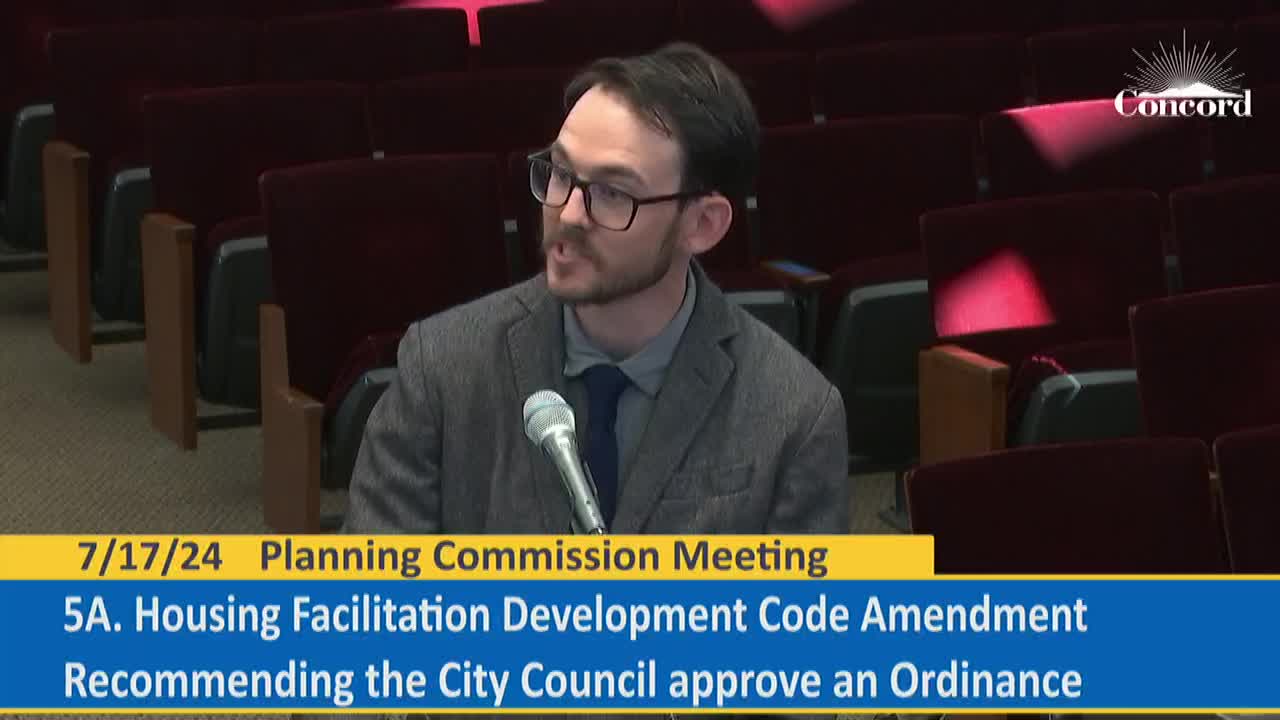Housing First Initiative Sparks Debate on Supportive Services
July 17, 2024 | Concord City, Contra Costa County, California

This article was created by AI summarizing key points discussed. AI makes mistakes, so for full details and context, please refer to the video of the full meeting. Please report any errors so we can fix them. Report an error »

During a recent government meeting, key discussions centered around supportive housing regulations, security requirements, and the concept of \"Housing First.\"
One significant topic was the 55-year affordability restriction for supportive housing. Questions arose regarding whether this restriction solely pertains to affordability or if it also includes requirements for supportive services after the 55 years. Officials indicated that they would review the code to clarify these implications, as the outcome could significantly impact housing policies.
The meeting also addressed security measures for supportive housing facilities. A commissioner raised concerns about the definition and scope of security guard responsibilities. It was confirmed that while a licensed security guard is required, the specifics of their roles would be outlined in a management and security plan, which must be submitted for review by planning staff and the police department.
Another important point of discussion was the access to permanent housing through low barrier navigation centers. Officials clarified that there is no set limit on how long individuals can stay in these centers, contrasting with emergency shelters, which have a six-month limit. This flexibility aims to ensure that clients are not turned away due to a lack of permanent housing options.
The concept of \"Housing First\" was also explained, emphasizing that stable housing is a prerequisite for individuals to address other life challenges, such as substance abuse or employment issues. This approach aims to provide a stable environment that facilitates personal growth and recovery.
Lastly, the meeting highlighted the legal requirements for low barrier navigation centers and supportive housing, noting that these facilities must comply with state law, which includes specific provisions for wraparound services and zoning clearances. Staff recommended that if a project does not meet these requirements, a use permit may be necessary, indicating a commitment to uphold standards beyond state mandates.
Overall, the discussions reflect ongoing efforts to navigate the complexities of supportive housing and ensure that regulations align with both community needs and state laws.
One significant topic was the 55-year affordability restriction for supportive housing. Questions arose regarding whether this restriction solely pertains to affordability or if it also includes requirements for supportive services after the 55 years. Officials indicated that they would review the code to clarify these implications, as the outcome could significantly impact housing policies.
The meeting also addressed security measures for supportive housing facilities. A commissioner raised concerns about the definition and scope of security guard responsibilities. It was confirmed that while a licensed security guard is required, the specifics of their roles would be outlined in a management and security plan, which must be submitted for review by planning staff and the police department.
Another important point of discussion was the access to permanent housing through low barrier navigation centers. Officials clarified that there is no set limit on how long individuals can stay in these centers, contrasting with emergency shelters, which have a six-month limit. This flexibility aims to ensure that clients are not turned away due to a lack of permanent housing options.
The concept of \"Housing First\" was also explained, emphasizing that stable housing is a prerequisite for individuals to address other life challenges, such as substance abuse or employment issues. This approach aims to provide a stable environment that facilitates personal growth and recovery.
Lastly, the meeting highlighted the legal requirements for low barrier navigation centers and supportive housing, noting that these facilities must comply with state law, which includes specific provisions for wraparound services and zoning clearances. Staff recommended that if a project does not meet these requirements, a use permit may be necessary, indicating a commitment to uphold standards beyond state mandates.
Overall, the discussions reflect ongoing efforts to navigate the complexities of supportive housing and ensure that regulations align with both community needs and state laws.
View full meeting
This article is based on a recent meeting—watch the full video and explore the complete transcript for deeper insights into the discussion.
View full meeting
